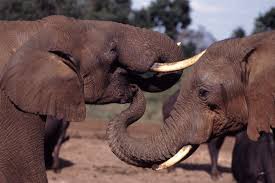Elephants Cheer Each Other Up by Putting Their Trunks in Each Other’s Mouths

It has thus far been difficult to prove that anecdotal observations of elephant empathy are real, as an ethical elephant expert does not necessarily want to stress out an elephant just to see if her friends send her a bunch of texts asking if everything’s okay and if she maybe wants to go out day drinking. But recently, a behavioral ecologist named Joshua Plotnik spent the better part of a year observing a pack of elephants on a 30-acre wildlife reserve, and took video of incidents like this:
The female Mae Perm rushes to the side of another adult female, Jokia, who was upset after hearing the roar of a captive bull elephant in another nearby park. Both elephants push their ears forward and raise their tails — but Mae Perm does so only after seeing Jokia’s distress. Mae Perm also makes loud chirps, which are known to be reassuring calls, and then caresses Jokia with her trunk, finally placing it in Jokia’s mouth — an act which “might send a signal, ‘I’m here to help you, not hurt you,’ ” Plotnik says. Jokia, in turn, places her trunk in Mae Perm’s mouth — a gesture which is probably like a hug.
Sometimes several elephants were present when one was spooked by something. These bystanders typically reacted the same way, adopting the agitated behavior of the victim, as Plotnik calls the distressed individual, raising their tails, flaring their ears, and sometimes urinating and defecating while chirping. In some cases, they also formed a protective circle around the victim.
Said another behavioral ecologist: “What is unclear is whether this reassurance primarily benefits the distressed animal, or the responders.” Indeed! [ScienceMag]